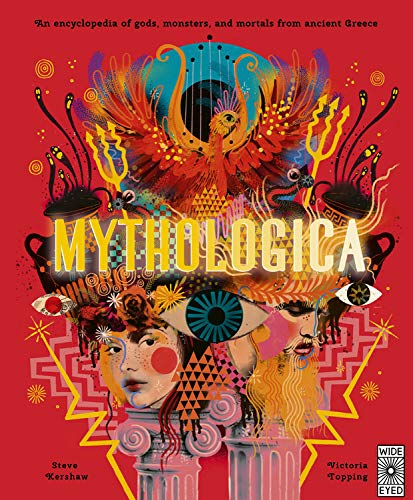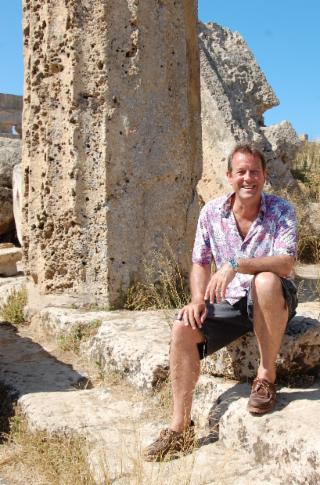Title of the work
Country of the First Edition
Country/countries of popularity
Original Language
First Edition Date
First Edition Details
Steve Kershaw, Mythologica. Minneapolis: Wide Eyed Editions (Quarto Group), 2016, 112 pp.
ISBN
Genre
Encyclopedias
Myths
Target Audience
Children (general public, elementary school age)
Cover

Cover courtesy of: Mythologica © 2019 Quarto Publishing plc.
Text © 2019 Steve Kershaw.
Illustrations © 2019 Victoria Topping.
Author of the Entry:
Ayelet Peer, Bar-Ilan University, ayelet.peer@biu.ac.il
Peer-reviewer of the Entry:
Lisa Maurice, Bar-Ilan University, Lisa.maurice@biu.ac.il
Daniel A. Nkemleke, University of Yaounde 1, nkemlekedan@yahoo.com

Courtesy of the author
Steve Kershaw (Author)
Dr. Steve Kershaw is an English author, academic and musician. He studied at the University of Bristol. Dr. Kershaw has been a Classics tutor for some 30 years. He currently works in the Oxford University Department for Continuing Education, creating and teaching courses for the weekly class programme, the MLA, summer schools, and online. He is also a Professor of the History of Art.
Dr. Kershaw has published several books on ancient antiquity, including, Barbarians: Rebellion and Resistance to the Roman Empire, A Brief History of Atlantis: Plato’s Ideal State, A Brief Guide to Classical Civilization, A Concise Dictionary of Classical Mythology (editor).
Source:
stevekershaw.com (accessed: July 29, 2020).
Bio prepared by Ayelet Peer, Bar-Ilan University, ayelet.peer@biu.ac.il
Questionnaire
1. What drew you to writing/working with Classical Antiquity?
I’ve loved these stories ever since I was a kid myself. I was lucky to attend a lovely Primary School in Halifax in Yorkshire, where, for the last 20 minutes of each day, our teachers would read to us from wonderful books. Then one day a new young teacher appeared in the school – a Classics graduate doing teaching practice, I think – and he read bits out of Homer’s Iliad and Odyssey to us. I thought this was totally amazing! Gods, monsters, heroes, fighting, astonishing adventures… I was entranced. I don’t remember doing it, but I must have gone home and enthused about these story-readings to my Mum and Dad, because my Grandpa bought me a copy of the Iliad (in translation, obviously! I learned Greek later). Like a good ten-year-old should, I read it with my torch under the bedclothes, and was completely drawn into the world of ‘Swift-footed’ Achilles, Hector the ‘Tamer of Horses’, ‘White-armed’ Helen, Thetis ‘of the Silver Feet’, and all the other brilliant characters. They became my friends, my enemies, my role-models, and my warnings, and they’ve stayed with me ever since...
2. And what challenges did you face in selecting, representing, or adapting particular myths or stories?
Selection was tough for Mythologica. The publisher said I could have 50 characters, split evenly between mortals, monsters and immortals. So in a way it had to be a ‘Greatest Hits’ collection. But it also had to provide sufficient visual interest for the illustrator – too many male warriors or snaky monsters would get boring, so we had to make compromises there, and I wanted a reasonable gender-balance between male/female characters/creatures too. Given the age-target of the readership, I had to tread a little carefully in terms of not too much sex & violence (Oedipus a big challenge, e.g.), although I left decisions about this up to my editor, and was happy to defer to those.
3. Why do you think classical / ancient myths, history, and literature continue to resonate with young audiences?
The narratives and he characters are very much the key here. I think: who wouldn’t love ‘Swift-footed’ Achilles, Hector the ‘Tamer of Horses’, ‘White-armed’ Helen, Thetis ‘of the Silver Feet’, and all the other brilliant characters, or the Odysseus’ incredible journey home from Troy, where you can marvel at with the grisly one-eyed cannibal Cyclops, imagine the song of the Sirens, and enjoy the cunning tricks that ‘Wily’ Odysseus played? Or going travelling with Trojan prince Aeneas and his band of refugees, and listening to his moving account of the fall of Troy, watching him break lovely Queen Dido’s heart, and accompanying him on his visit down into the Underworld? But there’s more - the wonderful thing about the Greek myths is that they are good to think with. They entrance us with the sheer magic of the storytelling, but at the same time we can find our own hidden meanings beneath the surface. These meanings won’t necessarily be the same for all of us, of course, because the myths speak to everyone in different ways. The stories are highly sophisticated, and lessons that do emerge from them aren’t always straightforward. Easy morals and messages are sometimes hard to find, and they don’t offer us glib, black-or-white answers. ‘And the moral of the story is…’ and, ‘They all lived happily ever after’, don’t happen very often. Yet that hasn’t stopped people using them to teach the values that they hold dear. That adaptability is a key to their enduring qualities, I think.
4. Do you have a background in classical education (Latin or Greek at school or classes at the University?) What sources are you using? Scholarly work? Wikipedia? Are there any books that made an impact on you in this respect?
Yes. Studies Latin & Greek at school; Classics degree at University; PhD in Classics; currently tutor for Oxford University, the V&A, the Arts Society, etc. Adult publications A Brief Guide to the Greek Myths (London: Robinson, 2007; A Brief History of Atlantis: Plato’s Ideal State (London: Robinson, 2017). Author and tutor of Oxford University’s Greek Mythology (Online) course
5. Did you think about how Classical Antiquity would translate for young readers, esp. in (insert relevant country)?
Not especially – I think it crosses cultural/national boundaries quite easily anyway. Mythologica has been translated into Greek, Russian, Spanish, Croatian, and Italian.
6. How concerned were you with ‘accuracy’ or ‘fidelity’ to the original? (another way of saying that might be — that I think writers are often more ‘faithful’ to originals in adapting its spirit rather than being tied down at the level of detail — is this something you thought about?)
Mythologica is an ‘encyclopedia’, so accuracy was very important – we needed 100% correct information (within the parameters of all the variants that these stories exist in – that posed challenges of selection etc. For me: which version of the tale do you tell in 200 words?)
7. Are you planning any further forays into classical material?
Always! Currently writing a book on the Persian Invasions of Greece for publication in 2022. A historical book really, but in fact there’s plenty of mythical material embedded in it. Not a children’s book, though.
Prepared by Ayelet Peer, Bar-Ilan University, ayelet.peer@biu.ac.il

Victoria Topping (Illustrator)
Victoria Topping is a well-known artist and illustrator. She has exhibited at solo exhibitions in the UK and Europe. Mythologica is Victoria’s first book illustration.
The artists is influenced by various aspects of music, from 70s jazz to disco. She has worked as an illustrator and a professional artist since 2008. She is also Artistic Director of On The Corner Records and has worked with Art Yard Records on Sun-Ra.
In her artwork she fuses traditional with the technological to create various layers.
Source:
Official website (accessed: July 29, 2020).
Profile at artrepublic.com (accessed: September 30, 2020).
Bio prepared by Ayelet Peer, Bar-Ilan University, ayelet.peer@biu.ac.il
Summary
This book is an encyclopaedia of ancient Greek mythology with accompanying colourful illustrations. It provides information on 55 gods and goddesses, heroes and monsters. few myths are elaborated on: “the labours of Heracles”, “the Trojan War” and the Argonauts. The book is very coulourful, the illustrations take up entire pages but also appear alongside the text. For all of the deities, their responsibilities are mentioned, where they are worshipped, their names also in ancient Greek spelling, origins, symbols and brief references to myths. The book is aimed at general audience and even younger readers hence sexual violence is omitted.
Analysis
As noted, the book is very colourful with original illustrations by Victoria Topping. It looks more like an art book than a regular illustrated encyclopaedia. The illustrations display an artistic reception and interpretation of the text. For example, in the portrayal of Aphrodite, we see a woman putting her hand to her red lips, perhaps symbolizing sensuality. She has a crown with a heart shape on it and a kind of halo from which hands spring out, each having a heart symbol in the middle. In her other hand she holds an orange apple with the word “kaliste” in Greek. Some of the divinities appear to be of darker skin, for example Gaia, Eros, Cassandra and Orpheus, among others. Penelope seems Asian. The illustrations look like the faces of regular humans from different cultures with fantastic attributes and costumes which make them stand apart. Hence Greek mythology is artistically interpreted as universal.
The book itself provides broad information on the various deities and mythological creatures which occupy Greek mythological stories. It perfectly complements the fantastic illustration and together, text and art work, give the impression of how Greek mythology is indeed mythical, fantastic and intriguing.
While the text is on one page, it still manages in its brevity to deliver a complete description of the mythological character, and even include more obscure facts. For example, the clothes Oedipus wore during his travels, or Aphrodite’s magical girdle, or Pandora’s jar. Including the characters of Penelope and Cassandra is an unusual choice made by author, who thought out to make these heroes equal with their male counterparts and also illustrate their suffering.


